Key takeaways:
- Preparation enhances the oyster festival experience; essentials include a cooler, favorite sauces, and sun protection, along with choosing the right companions.
- Understanding oyster varieties and their unique flavor profiles, as well as experimenting with beverage pairings, can elevate your tasting adventure.
- Engaging in festival activities, supporting sustainable practices, and learning about oyster terminology enrich your overall enjoyment and connection to the culinary experience.
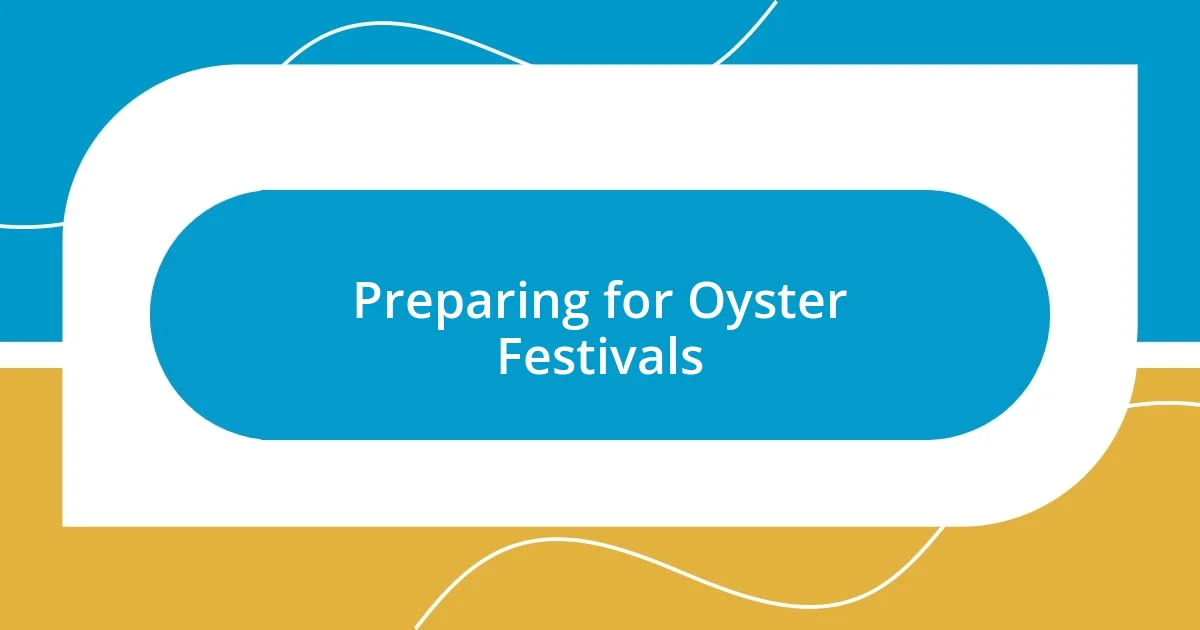
Preparing for Oyster Festivals
When I think about preparing for an oyster festival, I can’t help but get excited. Seriously, the anticipation of fresh oysters, tasty side dishes, and the vibrant atmosphere is palpable. Have you ever taken the time to research the festival’s schedule? Knowing the events that will unfold, from oyster shucking contests to live music, makes for a more enriching experience.
Packing for the occasion may seem simple, but I’ve learned that a few essentials make all the difference. Bring a soft-sided cooler for your purchases, a bottle of your favorite sauce, and, of course, a great sun hat! Remember my first festival when I didn’t prepare for the sun? I ended up with a sunburn that took weeks to fade. I promise, you’ll want to avoid that kind of discomfort.
Finally, consider your companions when gearing up for the festival. Whether it’s a close friend, family member, or even a date, sharing the experience adds to the magic. I still cherish the laughter and inside jokes from my first oyster festival with friends. It’s those connections that turn a fun day into a lasting memory. So, who are you planning to bring along?

Choosing the Right Festival
Choosing the right oyster festival can elevate your experience to a whole new level. I remember scrolling through festival websites, trying to find the one that ticked all my boxes—great oysters, lively vendors, and engaging activities. Each festival has its unique vibe and offerings, so it’s crucial to identify what matters most to you.
Here are some factors to consider when selecting a festival:
- Location: Is it close to home, or do you need a weekend getaway?
- Vendors: Are your favorite local oyster purveyors or food trucks listed?
- Activities: Will there be shucking competitions, live music, or cooking demonstrations?
- Size: Do you prefer the bustling energy of a large festival or the intimacy of a smaller gathering?
- Time of Year: Some festivals have specific oyster varieties that peak at certain times—research which ones align with the season!
By pondering these factors, you can find a festival that not only excites your taste buds but also resonates with your personal style. Trust me, picking the right one makes all the difference in creating those unforgettable memories!
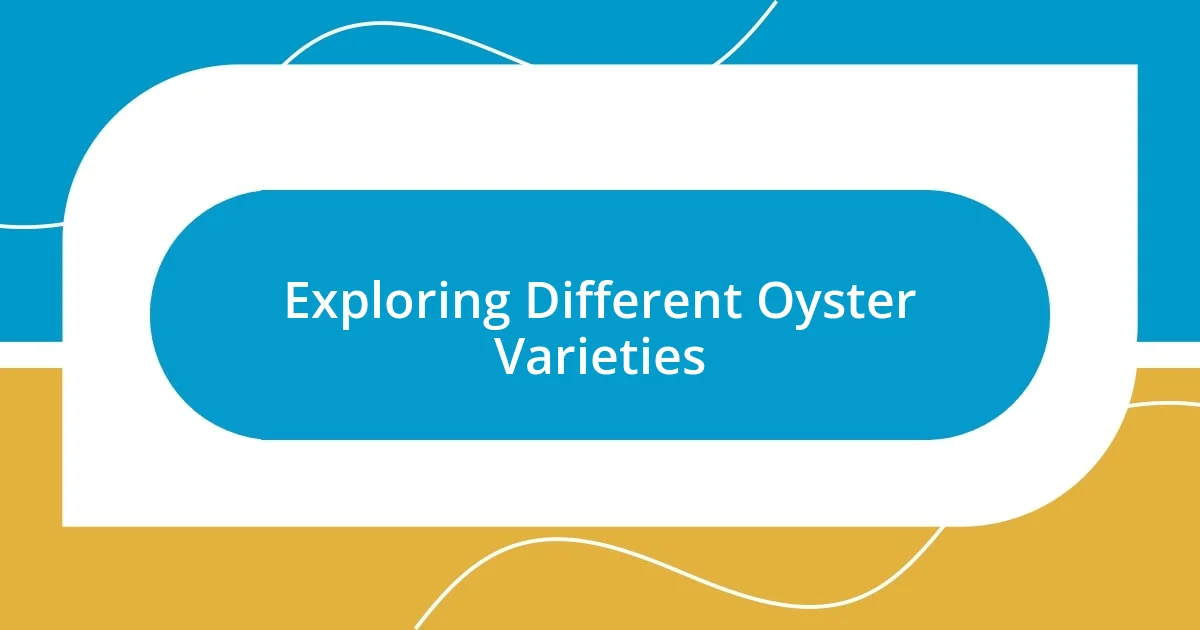
Exploring Different Oyster Varieties
When you dive into the world of oyster festivals, you can’t overlook the sheer variety of oysters available. I still remember the first time I sampled an Kumamoto oyster—it was like tasting the essence of the ocean, with its sweet, slightly fruity flavor and deep, creamy texture. Each type of oyster has its own personality, influenced by its growing environment, or habitat, which adds to the excitement of exploring different varieties at a festival.
As you navigate through the festival, take the time to ask vendors about the specific variety you’re trying. That’s exactly what I did at my second festival; I struck up a conversation with an oyster farmer who passionately described the unique brine of his Blue Points. I found myself appreciating not just the taste but the dedication and care that went into cultivating those delectable morsels. I encourage you to embrace this approach—connecting with the vendors often enriches the experience.
To help you understand some popular oyster varieties, here’s a quick comparison table:
| Oyster Variety | Flavor Profile | Region |
|---|---|---|
| Kumamoto | Sweet, briny, and buttery | West Coast, USA |
| Blue Point | Fresh, mild, and slightly sweet | East Coast, USA |
| Malpeque | Delicate, mineral-like flavor | Canada |
| Apalachicola | Salty, rich, and creamy | Florida, USA |
As you can see, each variety brings something unique to the table. It’s not just about taste; it’s about the journey each oyster has been on before it lands on your plate. Exploring these nuances can turn your oyster festival experience into a delightful adventure!
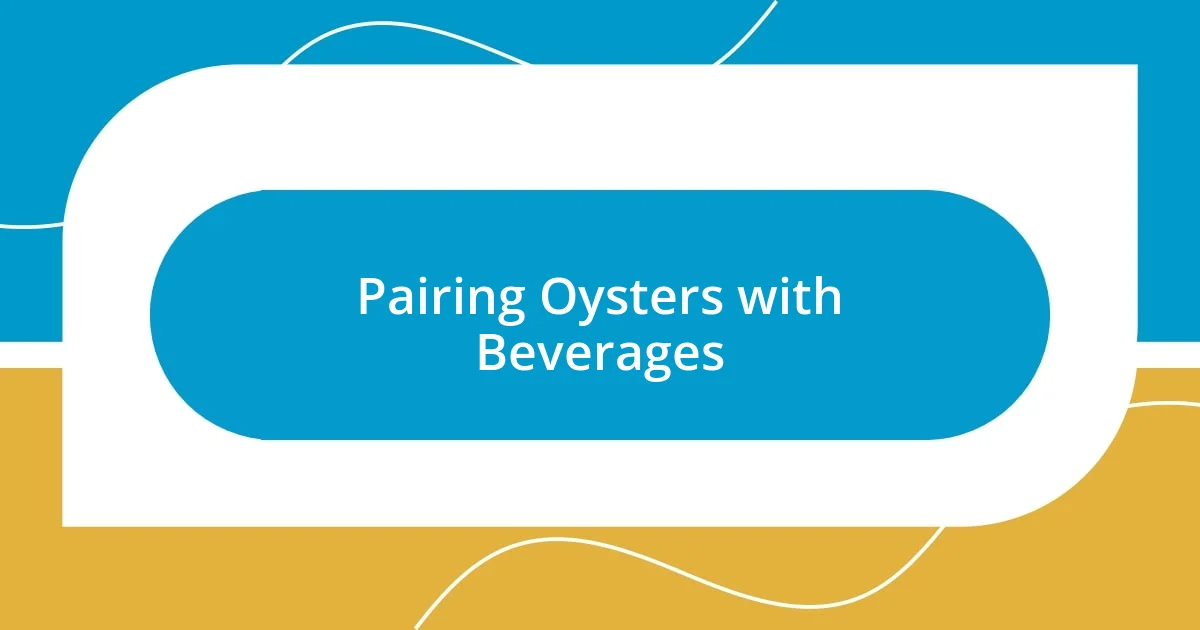
Pairing Oysters with Beverages
When it comes to pairing oysters with beverages, I find that experimenting can lead to delightful surprises. One of my favorite combinations is chilled Champagne with briny oysters. The effervescence cuts through the richness and enhances the flavors beautifully. I’ll never forget the first time I paired Kumamotos with a crisp dry brut; each sip made the experience feel elevated, like I was indulging in a taste of luxury.
For those looking for something a bit different, I recommend trying a light, hoppy IPA with your oysters. I was skeptical at first, but the bitterness of the beer actually complements the creamy texture of certain varieties. It’s all about contrast! Have you ever tasted an oyster while sipping a zesty Sauvignon Blanc? I can still remember that moment at a festival when the citrus notes of the wine paired perfectly with the minerality of a Malpeque oyster—pure bliss!
Don’t forget non-alcoholic options, either. Sparkling water with a splash of lime is a refreshing choice that keeps the focus on the oysters. I once enjoyed this pairing at a seaside festival, and it allowed me to savor each bite while staying hydrated under the sun. Which drink will you choose to enhance your oyster experience? Trust me, the right pairing can turn a good festival visit into an unforgettable culinary adventure!
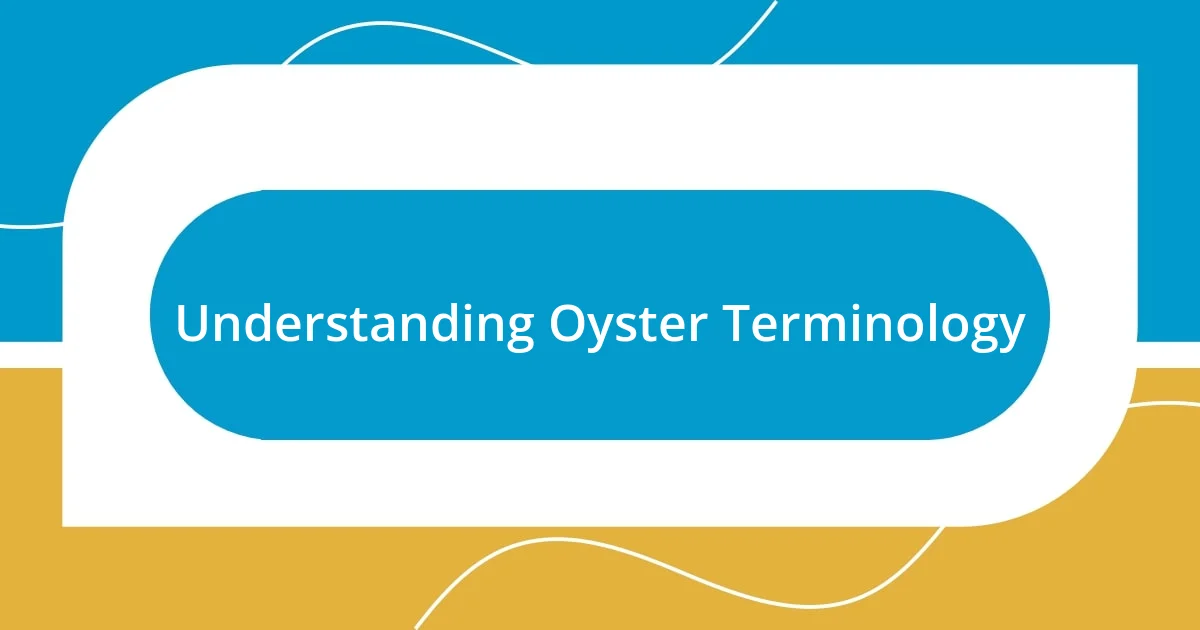
Understanding Oyster Terminology
When exploring oysters, it’s crucial to grasp some key terms that pop up often. For example, the term “brininess” describes the salty quality of oysters, which varies based on where they’re harvested. I still recall the first time someone explained this to me—it opened my eyes to the unique flavors and experiences that different regions offer. Ever wondered why a certain oyster makes your taste buds dance? Brininess is often a significant factor!
Another important term is “merroir,” a concept akin to “terroir” in wine. It encompasses the environmental conditions that influence an oyster’s flavor, from water salinity to the local algae they feed on. The first time I heard about this, it felt like an unveiling of a secret language among oyster lovers. Can you imagine how the same oyster species can taste different based on where it’s grown? It’s remarkable how the ocean adds its own character to each pearl of the sea.
Lastly, familiarize yourself with “shucking,” the process of opening an oyster to eat it. I remember my first attempt; it was both thrilling and a bit intimidating. The technique is essential for enjoying fresh oysters, as the right shucking technique can preserve the meat’s quality and flavor. It’s worth practicing or even attending a demonstration at a festival. Knowing these terms not only enhances your appreciation but also makes conversations with vendors and fellow oyster enthusiasts much richer—don’t you agree?

Engaging with Festival Activities
Engaging with festival activities is a fantastic way to immerse yourself in the vibrant atmosphere that oyster festivals offer. One year, I stumbled upon an oyster shucking competition at a festival, and it was such a thrilling experience! Watching skilled shuckers work their magic was not just entertaining; it also inspired me to pick up my own shucking knife and give it a whirl. Have you ever tried shucking? It’s empowering and allows you to appreciate the effort behind serving those beautiful oysters!
Participating in hands-on workshops adds another layer of fun. At one festival, I attended a session that taught different oyster preparation techniques, from grilling to poaching. I vividly remember the aroma of garlic butter filling the air as we learned to prepare oysters on the grill. I left that day not just with new recipes but a sense of connection to the food I love. Have you found a cooking class at a festival? Just imagine how enjoyable it is to recreate those festival flavors back home!
Lastly, don’t overlook interactive tastings! I recall the excitement of joining a guided tasting where each batch of oysters was paired with unique dips. The thrill of discovering new flavor combinations is truly unforgettable. There was one particular dip—spicy horseradish infused with lime—that had everyone talking. Engaging with these activities not only deepens your knowledge but also builds a community with fellow festival-goers who share your love for oysters. Isn’t that what makes these festivals so special?
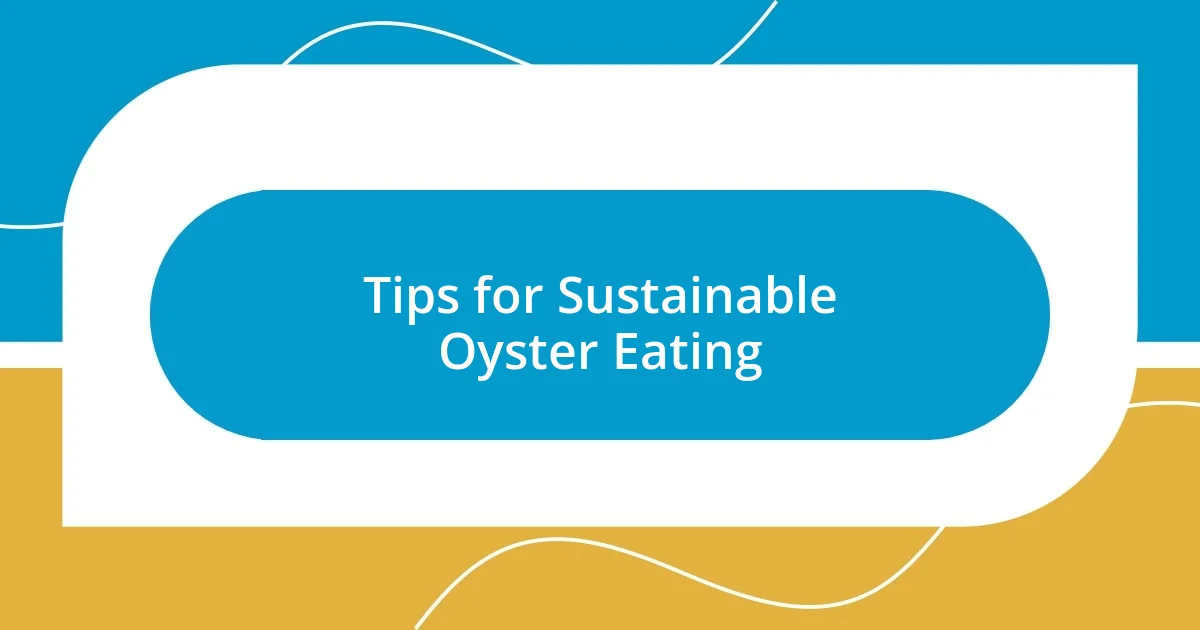
Tips for Sustainable Oyster Eating
When indulging in oysters, choosing sustainably sourced options truly enhances the experience. I remember visiting an oyster farm where the farmers emphasized their eco-friendly practices. It was fascinating to see how careful management of the natural habitat directly contributes to healthier oyster populations. Have you ever thought about the impact of your choices on the environment? Supporting local farms not only boosts the economy but also encourages practices that protect marine ecosystems.
Another effective tip is to pay attention to the harvesting seasons. Oysters are generally best enjoyed during specific months, often referred to as the “R” months (September through April). I distinctly recall the excitement I felt tasting a fresh batch of oysters in October, knowing they were at their peak flavor. Understanding these seasons allows us to savor them when they’re most delicious while also promoting sustainable fishing practices. Isn’t it rewarding to enjoy your food knowing it aligns with nature’s rhythm?
Lastly, remember to ask vendors about their sustainability practices. I’ve often found that those who love their craft are more than willing to share their story. One festival, I spoke with a vendor who explained their commitment to ocean conservation. Listening to their passion ignited my own appreciation for the delicacy on my plate. Don’t you find that a personal connection with your food enhances your dining experience? Engaging in these conversations not only elevates your journey but also encourages a culture of sustainability within the culinary scene.














